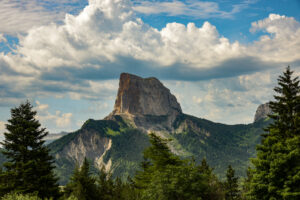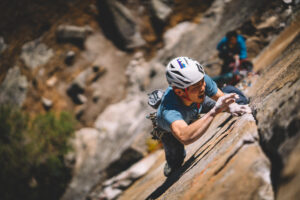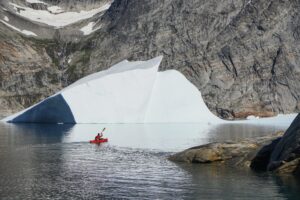Last month, American Alex Honnold and Hazel Findlay of the UK made the first ascent of Ingmikortilaq, a huge granite-gneiss monolith in Eastern Greenland.
Honnold and Findlay climbed the north-facing wall via the northeast ridge within five days. On this 1,140m wall, they fought subzero temperatures, loose rock, and storms. They had to access the climb directly from the cold fiord waters.

Alex Honnold and Hazel Findlay discuss their route before the climb. Photo: J.J.Kelley/National Geographic for Disney+
“It’s definitely one of the biggest first ascents I’ve ever done, and one of the most stressful because of how dangerous the climbing was,” Honnold said.
Without a doubt, this was an impressive climb of a huge cliff. But it raises an interesting question: Should this be considered a big wall or a mountain in the form of a monolith? Honnold believes it is more a mountain than a true big wall.

The team treks over melting ice. Photo: Alex Honnold
What makes a big-wall climb?
What’s the difference? As big-wall climbers John Long and John Middendorf wrote in their book Big Walls, there is no precise definition to automatically qualify a cliff as a big wall. Any chunk of steep, mostly vertical rock that’s high enough is a candidate.
A basic definition of big-wall climbing is a multi-day rock climbing requiring mainly artificial techniques to ascend multiple pitches on very steep, highly technical rock faces, typically vertical walls.

Yosemite at its best. Half Dome and El Capitan. Photo: Lorenzo Alesi
“As opposed to free climbing, artificial or direct aid climbing entails the mechanical, mentally taxing, and sometimes perilous task of ascending steep rock via strings of weight-bearing equipment fitted, slotted, and hammered into the rock,” Long and Middendorf wrote. However, a big-wall climb may also contain some sections where the climbers have to free climb.
Big-wall climber Chris MacNamara wrote in his book How to Big Wall Climb that “Big walls are all about vertical exposure; climbing and sleeping with thousands of feet of air below you and thousands of feet of rock above you. There is nothing else like this.”
An interesting debate
A few years ago, on Mountain Project’s big-wall and aid-climbing forum, there was an interesting discussion: What exactly is a big wall? Most agreed that the height needed to be at least 450m or more and that a climber had to spend more than one day on a practically vertical wall, aid climbing, on a multi-pitch route.
However, others noted that some traditional big-wall routes were now being climbed in a day, and even free climbed, and therefore the definition became less clear. However, that shouldn’t change its original meaning, where the keywords are: steep, vertical, rock climbing, artificial aid, portaledge and hauling system, multi-pitch, aided climb, and two or more days to complete the route. It doesn’t matter that some climbers managed to ascend certain big walls in free climb or even a free solo.

Walker Citadel, Sam Ford Fiord, Baffin Island. Photo: Jerry Kobalenko
One climber added that he had climbed El Capitan a couple of dozen times, sometimes in a day, sometimes in multiple days: “I count all of them as a climb of the big wall.”
Confusingly, some commenters tried to draw a distinction between a “bigwall” and a “big wall”, stating that you can climb a big wall fast, but a bigwall is very slow to ascend. Another suggested that you could define a big wall as a steep rock wall of grade IV or greater. These tall or steeper faces have few ledges and small cracks.
Whatever the definition, for some climbers, size matters. Though any near vertical rock wall longer than 50m will do, the pursuit of the world’s largest big walls is part of the allure.
The name game
What is a wall?
Every mountain has different faces. These faces can include a buttress, ridge, wall, pillar, etc.
When the massive, compact character of part of the the face is evident, we call it a wall. For example, the East Face of 6,344m Siula Grande in the Andes. The first climbers to ascend the East Face of Siula of this “Touching the Void” peak were Max Bonniot and Didier Jourdain in 2016, via the East Pillar/Southeast Ridge.
In July 2022, two Catalan climbers, Marc Toralles and Bru Busom, climbed the East Wall of Siula Grande for the first time (Anima de Corall route). Their overall climb is considered alpine style, although the difficult first part was in big-wall style.

The Catalan route on the East Wall; and the French route (in red) on the East Pillar/Southeast Ridge on the East Face of Siula Grande. Photos: Marc Toralles/Bru Busom and Max Bonniot/Didier Jourdain
And what about the Rupal Face, the Shining Wall of Gasherbrum IV, the North Face of the Eiger or the Matterhorn, or Masherbrum’s West Face? They can’t be considered big walls, from the point of view of big-wall climbing.
For example, El Capitan, or the Grand Voyage route on the Great Trango Tower, are pure rock, and they are different from those huge walls that include mixed terrain, where the use of ice tools is necessary, as in the case of the Shining Wall and the others above. There, the climbing is alpine-style, not big-wall style. The wall is not vertical, it’s not pure rock-climbing, and the tools are different too.
The late David Lama once described Masherbrum as like the Eiger, with Cerro Torre above. Certainly, the upper section may require big-wall climbing techniques.
Big wall, big-wall, or bigwall?
Try to wrap your head around this: While all bigwalls or big walls are big (huge) walls, not all big (huge) walls are a bigwall (or a big wall) for the reasons we mentioned above.
As a matter of writing style, big-wall climbing is usually written with a hyphen, while “big wall” as a noun does not have a hyphen. But climbers often write bigwall as something specific to climbing, while “big wall” means something more general.
ExplorersWeb asked John Middendorf and Damien Gildea about the terminology. Middendorf preferred “bigwall” but admitted that it was a made-up term. Gildea said that “‘big wall’ is not wrong but is a bit general.”

Voytek Kurtyka climbing West Face of Gasherbrum IV, aka the Shining Wall. Photos: Robert Schauer and Arcteryx Blog
Does it matter which wall is the largest?
John Middendorf points out that people like to use superlatives when talking about big walls: tallest, hardest, longest, most overhanging. “But that is not the point,” he says. He prefers not to make comparisons and believes that it is not a competition.
Middendorf and Xaver Bongard climbed the incredibly large Grand Voyage route on Great Trango Tower in 1992. It is one of the largest big-wall climbs ever completed. Speaking to ExplorersWeb, Middendorf was modest and careful not to over-hype their climb.
“I’m not sure I am happy saying that my route was the biggest,” he told ExplorersWeb. “I think it is correct to say that Great Trango is the biggest overhanging/vertical chunk of rock in the world, as I have not seen anything that matches it. [Rival candidates] like Polar Sun Spire and Thor, are not as big.”
Middendorf explained that they weren’t climbing for a record or because of the length of the route, but to have fun.

Great Trango Tower, Pakistan. Photo: John Middendorf
Middendorf is technically right. Their Grand Voyage route took in 1,340m of exposed big-wall climbing on what might be the world’s biggest wall, but the Norwegian route (the Route of No Return) is longer, at over 1,520m.
Of course, the Norwegians did not finish their climb on No Return, suffering a fatal fall during their descent.
According to Middendorf, some walls in the fiords of eastern Baffin Island may be even larger than Great Trango Tower, but most of their bulk are underwater.

Sam Ford Fiord, Baffin Island, with Polar Sun Spire on the right. Photo: Jerry Kobalenko
What makes big-wall climbing different?
Difficulty

Streaked Wall in Zion National Park, USA. Photo: Atlas and Boots
“Big wall climbing is not about summit glory, pulling off a single hard move, or savoring the rush of adrenaline, although all three of those things will happen,” McNamara wrote in How to Big Wall Climb. “The experience is much more complex and rich. You don’t flirt briefly with gravity as you might while BASE jumping or doing a hard single-pitch climb. You live with the pull of gravity and daunting exposure 24 hours a day.”

Cerro Torre, El Chalten, Argentina. Photo: Davide Brighenti
It is a game of patience, where resistance and mental strength are important. A climber sometimes spends several days or even weeks on a wall. Depending on its location, you may be a long way from help if an accident happens. If you sleep on a portaledge, you can’t drop anything into the void.
Tackling a big-wall climb alone heightens the commitment still further.
Strategy
Calculating enough food and drink for the team during such an open-ended climb is vital. “Big walls require putting together a lot of unfamiliar skills and logistics,” McNamara wrote.

Notch Peak, the second highest vertical drop in the USA. Photo: Millard County Tourism
Climbers often get in trouble because they have made simple mistakes in food arithmetic or because adverse weather has led to long waits on the wall. This happened to the Norwegians on Great Trango Tower. Short of food and water, two of the four decided to turn back before reaching the top, so that their teammates could advance. But perhaps it was their salvation. The two summiters later died on the descent.
Two people need a minimum of 30 litres of water for five days on a big wall and they have to schlep it all up with them. McNamara points out two keys: Keep it simple and master the basics of aid-climbing. This sort of climbing is never about speed. It’s about climbing efficiently, which is different.

Mount Thor, Auyuittuq National Park, Canada. Photo: Cory Trepanier
Conclusion
You could argue that big-wall climbing is one of the most honest forms of climbing, together with free climbing and free soloing. Trackers aren’t needed, there are no false summits, no supplemental oxygen, no confusing stories, and no need for detective work based on witness testimonies. You can be seen on the huge wall, like small beetles, moving up the granite. You top out or you don’t. There is no in-between.






